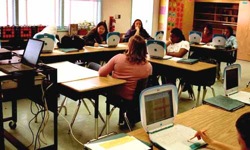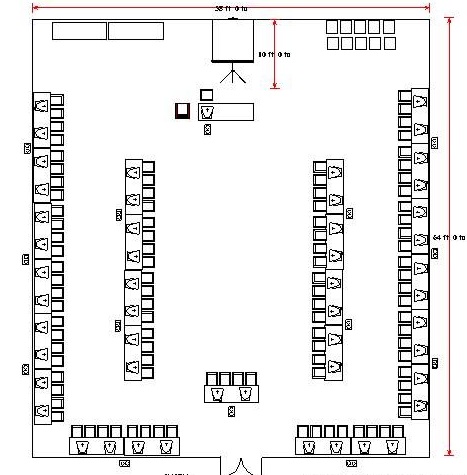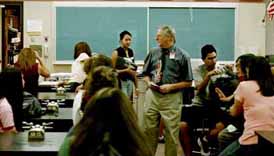
fno.org
|
|
| Vol 18|No 2|November 2008 | |
| Please feel free to e-mail this article to a friend, a principal, a parent, a colleague, a teacher librarian, a college professor, a poet, a magician, a vendor, an artist, a juggler, a student, a news reporter or to anyone else you think might enjoy it. | |||||
Getting Attention
By Jamie McKenzie, ©2008, all rights reserved. |
 Australian teachers learning in a laptop classroom. © 2008, J. McKenzie |
||||
|
Over the years we have seen little time or funding devoted to professional development (PD) that might equip teachers with the skills required to make smart and productive use of new technologies. What little PD we have seen was devoted mainly to the learning of software and how to operate the latest toys. We have too often placed carts before horses. Managing learning in the laptop classroom requires considerable savvy. This article explores the dimensions and characteristics of such classrooms, identifies the chief challenges facing teachers in such space, and suggests moves, tactics, strategies, tricks and scaffolding designed to optimize student learning. Pedagogy does matter, but it has been pretty much ignored during the design of PD offerings. Note the article "Pedagogy Does Matter!" at http://www.fno.org/sept03/pedagogy.html A Google search for "laptop classroom" and "pedagogy" turns up few articles with much to offer. The one exception is a fine study by Ewa McGrail at Georgia State University, "Laptop Technology and Pedagogy in the English Language Arts Classroom," JOURNAL OF TECHNOLOGY AND TEACHER EDUCATION, 2007. 59-85. (article in PDF file) McGrail's abstract echoes the themes of this article:
A successful lesson results from mindful devotion to the following elements, each of which will be addressed later in this article:
An effective teacher knows how to orchestrate these elements to match the characteristics of the students, adapting to each group as the lesson proceeds. It is difficult to design a lesson in advance because teaching and learning involve interaction and chemistry. The teacher should be alert to adjustments required by this interaction. What works well with a second period class may fail when tried with a different group at the end of the day. 1. Lesson Objectives, Content and Design The presence of laptops in a classroom should not dictate the nature of lesson design. That would be allowing the tool to determine the learning. Sound instruction calls for clarity about goals prior to the selection of equipment. Sadly, in many schools, the tools have become defining elements when they should not be. A laptop school? A laptop classroom? Would it not be more encouraging to witness the spread of thinking schools and questioning classrooms? Our goal is to grow young thinkers. This is not about laptopping children. It is about educating them. We should not do technology for the sake of technology or go digital simply because it is fashionable. We begin by establishing learning goals, and then we identify the activities most likely to carry the day. Example: A high school English teacher developing the media awareness of students makes the critical thinking and comprehension skills embedded in media literacy the focus of the unit's lessons. Eager for students to apply these skills across a range of media, the teacher shifts back and forth from print to television to online blogs, magazines and news Web sites like CNN. (Note article "Photoshopping Reality: Journalistic Ethics in an Age of Virtual Truth." At times during this unit on media literacy, all books and all laptops will be shut. The teacher may display an ad up on the classroom's screen where all can focus.
The teacher has chosen a technique that brings the class together with eyes forward. Perhaps they could have all seen the same ad on their separate laptops, but classroom interaction would have been quite different. The teacher has their attention - an aspect of classroom learning that is inadequately considered in the literature on new technologies in schools. Note article "Putting Technology in Its Place." The ad being viewed by the class comes from the Dove Foundation. Dove Evolution shows a young woman being photoshopped for a billboard, ostensibly raising issues about the impact of the beauty industry on young women's self images. The teacher downloaded the file from the Web at home, knowing that the school's network would perform poorly when trying to show such streaming video. At the same time, the decision to show the video up front was determined by a desire for attention at the outset of the lesson.
"Dove Onslaught" available at As the lesson and the unit proceeds, the teacher is clear about purpose and intentions. The class will shift in and out of various equipment configurations according to the benefits of each. At times students will work solo on separate laptops. At times they will team in groups of six sharing just two laptops. At other times, the class will sit in one big circle and share personal reactions while all equipment is cooling.
This design has been popular for many decades and serves classroom lecturing fairly well, but effective teachers will ask students to move furniture around to meet lesson objectives, since some arrangements serve particular learning goals better than others. Constructivist learning activities, for example, thrive when furniture is not arranged in rows as it is for didactic lessons. Example: To illustrate this landscape issue, consider a seventh grade social studies teacher asking students to debate the wisdom of offshore drilling. The class began with all seats facing forward. The teacher points to a chart on the white board showing fastest times for 8 different furniture arrangements in this class (list). She holds up a stopwatch.
It takes the students less than a minute to change the room to match the learning activity. They can now glance across the room and concentrate on their opponents and the ideas at stake. The teacher may still direct the flow, but attention has been shifted intentionally away from the front of the room to the other students. On some days the teacher may allow students to keep laptops open to consult research done in previous classes or to take notes. There may be a ground rule that blocks browsing during the debate. The teacher may have developed class norms that distinguish between productive and acceptable browsing in contrast with diversionary wandering that would dilute the attention being paid to the debate. On some days all laptops will be shut.
A major theme of this article is the importance of teachers being able to see the students' screens when they are working on challenges and tasks assigned by the teacher. While there is now software available to allow such monitoring from the teacher's computer, most teachers must rely upon a technique we will call eyeballing. Certain furniture arrangements are more supportive of eyeballing than others, and thanks to the arrival of wireless laptops, movement and flexibility are now real options in many schools. Even though movement and flexibility are options, many teachers have worked through decades of arranging rows to face the front. Those habits are sometimes deepseated and hard to shed. During the past ten years, I have successfully employed the arrangement shown in the diagram below to handle class sizes of 50-175 working hands-on as pairs or trios.
In this situation, when I need the full attention of the class for 5-10 minutes, I will ask them to swivel around and join me. They turn their eyes forward on me and the screen. Sometimes I am initiating a group discussion, in which case, they will swivel around and face each other in one large "C" shaped grouping. Sometimes I will invite them to turn with laptops on laps because they have important work just completed that they might need to share. Other times I will ask participants to turn their backs on the laptops because they might prove a distraction. Most times when I hold these sessions, several teachers will enter the room and move the laptops around so they are sitting on the opposite side of the tables from the side I intended. Accustomed to facing the front of a classroom, they are most comfortable sitting facing the front of the classroom with a laptop between me and them. This is a teachable moment, as it offers an opportunity to mention classroom landscape and provide a brief explanation of why I have set up the room in the way I have. Even after this explanation, they are usually skeptical. As the day proceeds, we hold a number of discussions of landscape, monitoring, eyeballing and attention. By the afternoon, some of the skeptics have seen the light and embraced the strategy. Others are tenacious, sticking with what they have always known. During the day, there are times when participants are asked to gather with six chairs and two laptops. At other times they are urged to go anywhere in the building for fifteen minutes to work on a challenge. The configuration that greets them in the morning morphs, shifting and adjusting as the activities change. A teacher who ignores landscape in laptop classrooms is likely to encounter difficulties with classroom management. A useful Web site outlining some of these issues can be found at http://www.asbindia.info:8081/drupal/Tech@ASB/?q=node/81 Culture is yet another topic neglected by those who believe equipment will transform classrooms and learning. Success with a room full of laptops requires attention to attitudes and norms. The behaviors of students will either support or undermine the learning depending upon the classroom culture. If a teacher has five classes, it is likely that each will be quite different from the others in terms of attitudes and behaviors. These can be developed by a savvy teacher who understands culture. If a group starts the year as an uncooperative, untrustworthy mob, the teacher acculturates them. Failure to address attitudes and norms would normally lead to chaos. If the group starts off with more positive norms, the teacher takes them to ever more advanced levels. A good teacher invests in organizational development. What are the most important aspects of classroom culture when it comes to laptop classrooms?
4. Teaching Moves, Strategies, Tactics and Procedures
There are hundreds if not thousands of specific moves and tactics that can help to make a teacher successful in this kind of classroom. This article cannot list all of them, but it will offer some concrete examples. Example 1: An effective teacher will instruct students to move the furniture around as mentioned earlier to match the landscape to the activity. Example 2: An effective teacher will move about the room when students are working on laptop challenges, checking, monitoring, assisting and intervening or supporting as necessary. Example 3: An effective teacher will scan the room with frequency to figure out where to move next but will also use eyeballing and eye contact to make some of those movements less necessary as many students respond well to such gestures. Example 4: An effective teacher will announce a coming shift of activity with enough time so that students can wrap up what they are doing. "In two minutes I will be asking you to turn around and join me for the next activity." Example 5: An effective teacher will ask students to "shut laptop lids" when laptops would not prove useful. Sometimes a single laptop shared by a pair or trio works better than one-on-one. Sometimes a group discussion is best served by cooling laptops. Example 6: An effective teacher will call for complete attention prior to demonstrating a series of instructions. "I need 100 per cent eye contact now." Example 7: An effective teacher will hold many conferences with individual students and teams, guiding, suggesting, encouraging and supporting their work in various ways. Example 8: An effective teacher will devote lots of energy to assessment, most of it informal, asking how things are going and what needs to be adjusted. Districts with an interest in laptop classrooms (whether they be one-on-one or shared laptops) would be wise to offer a 2-3 year professional development offering that would focus on equipping all teachers with these moves, tactics and strategies. This program would offer guided practice and mini-teaching as well as support groups so that teachers can acquire the skills by doing rather than mere listening and watching. Teachers move from theory into practice thanks to learning communities. The most effective laptop classrooms will provide a full range of technologies rather than surrender to simplistic laptop definitions. In some schools, the desire to give every student a personal laptop leads to some very bad choices.
The most effective laptop classrooms will view laptops as just one element within a complex array of tools that extends to mundane items such as blackout curtains and chairs. Good planning orchestrates all of these elements so as to optimize learning, but grandiose visions sometimes subvert such planning. One can visit laptop classrooms where every student has a computer but the room is so awash with sunlight that the projector cannot be used. There are also many classrooms where the chairs and tables are better suited to a didactic classroom of the 1950s. Putting all one's eggs into a laptop basket leaves no money for swivel chairs or trapezoidal tables. While rarely noted, a classroom with shared laptops is also a laptop classroom. The choice of equipment should closely match the learning activities intended for that classroom space. Sadly, to question the wisdom of one-on-one computing is like pointing out the Emperor's nakedness. Many classrooms end up missing important items thanks to the one-on-one myth. Authentic discussion of alternatives is often blocked by the egos of so-called visionaries who are intent on imposing their ill-considered dreams on others. Often these visionaries work outside of schools and presume to know best how to improve an enterprise about which they are fundamentally ignorant. Big bucks do not always translate into effective policy, as can be seen with the ill-fated small schools effort launched by the Bill and Melinda Gates Foundation (see article). As mentioned earlier, the effective teacher in a laptop classroom will devote a good deal of energy to gauging effectiveness of lessons, strategies and activities, employing a range of techniques that include eyeballing and conferencing as well as rubrics developed by the students themselves. To the extent that these assessment techniques become shared classroom practices, the program can deepen and improve. There have been few convincing studies of the impact of laptop programs upon student learning, in part, perhaps, because visionaries rarely tolerate such veracity. Most studies list doubts such as Dunleavy and Heinecke, "What added value does a 1:1 student to laptop ratio bring to technology-supported teaching and learning?" in the Journal of Computer Assisted Learning:
8 different furniture arrangements
|
|||||
|
Copyright Policy: Materials published in From Now On may be duplicated in hard copy format if unchanged in format and content for educational, nonprofit school district and university use only and may also be sent from person to person by e-mail. This copyright statement must be included. All other uses, transmissions and duplications are prohibited unless permission is granted expressly. Showing these pages remotely through frames is not permitted. |
|||||

 Landscape is rarely discussed in many schools. In some schools, the desks, the tables and the chairs rarely move. Visitors can walk down the halls of many high schools and find nearly all the classrooms organized with rows of desks facing the front. At the front sits a teacher desk and a lectern as well as a presentation table that might hold equipment such as an overhead projector or a video projector and document camera. Sometimes equipment hangs from the ceiling or peers out from a corner.
Landscape is rarely discussed in many schools. In some schools, the desks, the tables and the chairs rarely move. Visitors can walk down the halls of many high schools and find nearly all the classrooms organized with rows of desks facing the front. At the front sits a teacher desk and a lectern as well as a presentation table that might hold equipment such as an overhead projector or a video projector and document camera. Sometimes equipment hangs from the ceiling or peers out from a corner.

 A laptop classroom requires quite a repertoire of moves, strategies, tactics and procedures to make sure learning occurs. Sadly, professional development in few districts has supplied much assistance to teachers who wonder about the management of such classrooms.
A laptop classroom requires quite a repertoire of moves, strategies, tactics and procedures to make sure learning occurs. Sadly, professional development in few districts has supplied much assistance to teachers who wonder about the management of such classrooms. 